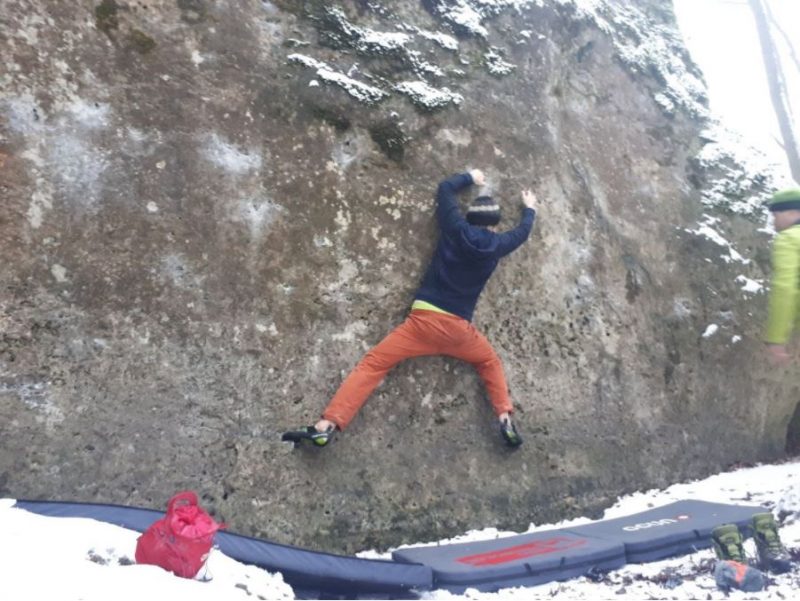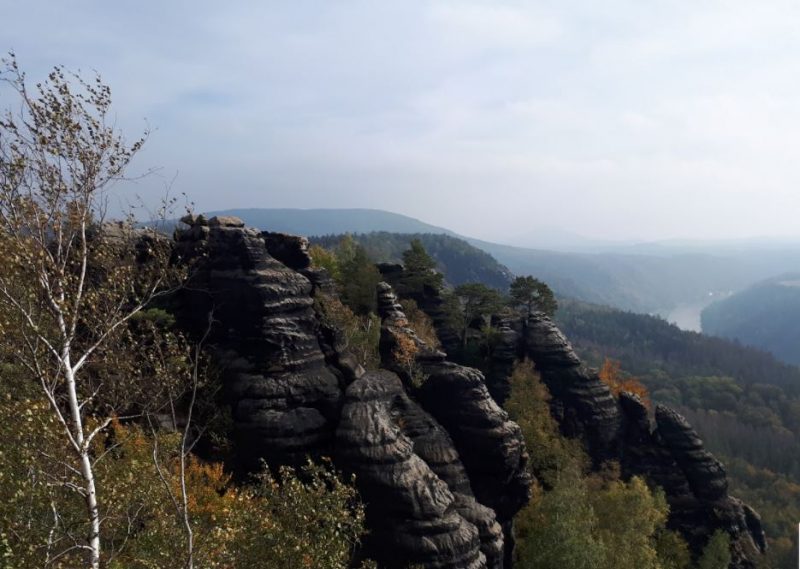As the sport of climbing becomes ever more popular, enthusiastic climbers are keen to develop and expand new outdoor locations to put their skills to the test. The last couple of decades has seen Germany embrace the sometimes controversial sport and build a thriving climbing culture in several spots across the country.
Introduction to Climbing in Germany
While Germany may not have the gorgeous climate of Costa Blanca or the Istrian Peninsula, many climbers flock to German crags in the warmest months to avoid the blistering summer heat of Southern Europe and the thorough maintenance of routes and existing equipment as regulated by the DAV helps fill nervous climbers with confidence in their moments of vulnerability.
Below are some of our favorite locations for rock climbing in Germany, including some of the best sport climbing and best bouldering spots in Europe.
Best Rock Climbing Locations in Germany
1. Frankenjura
The Frankenjura is truly the mecca of sports climbing in Germany. Situated between Bayreuth, Bamberg, and Nürnberg, the rolling forest is home to over 13,000 single pitch sport routes spread across more than 1000 crags. The gnarly limestone was the former stomping ground of some of the climbing greats, such as Wolfgang Güllich and Kurt Albert, and has helped to engineer the unstoppable force that is Alexander Megos. Knowledge of the Frankenjura spreads far beyond the boundaries of Germany, and eager climbers flock from all over the world to try out their skills on some of the best sport climbing in Europe.

Great for Sports Climbing (and unofficially some bouldering)
The Frankenjura is home to a few world-famous climbing routes. The most widely known route is Action Directe, the world’s first-ever 9a (although there is some debate over this as Hubble in the UK might be upgraded to 9a and was climbed beforehand). The first ascent of Action Direct was by Wolfgang Güllich in 1991 and was recently repeated by Mélissa Le Nevé in the first female ascent in 2020. Other notable but difficult routes are Wall Street and Devil’s Crack.
As there are so many routes, there is something for everybody, ranging from beginner to expert in difficulty. The typical climbing style is slightly overhanging and largely utilizing natural pockets in the surface of the limestone.
The majority of the climbing in the area is single pitch sport routes, with routes above 35m being exceptions. These are detailed in two climbing guides published by Panico Alpinverlag called Kletterführer Frankenjura Band 1 and Kletterführer Frankenjura Band 2, that cover the area north of Nürnberg. These are frequently updated with new routes and gradings as these develop over time. There is also a guide for the area south of Nürnberg called Kletterführer Südlicher Frankenjura. App, however, this is somewhat less popular than the area in the Fränkische Schweiz, although still a fantastic place to climb.
There is a certain amount of bouldering in the Frankenjura, although it is forbidden to publish any information about it despite it being tolerated and accepted as an outdoor activity. For this reason, we will not disclose any information about bouldering locations, but we will say that if you are eager, you can ask the local climbing community who are likely to show you where to go, particularly if you entice them with a beer.
And if that’s not exciting enough, the sub-state of Franconia where the Frankenjura is located has the highest brewery per capita ratio in the world.
2. Sächsische Schweiz
Located in the East of Germany and right next to the Czech Border is the Sächsische Schweiz, which translates to “Saxonian Switzerland” (Schweiz is a German word for a hilly area, as well as the German word for “Switzerland”, which is also a hilly area). This national park consists of a vast area of Elbsandstein stacks that tower high above the rolling landscape. It is popular for hiking, mountain biking, and especially attractive for trad-climbers.

Great for Multi-Pitching and Trad Climbing (and unofficially some bouldering)
While the area has some of the most fantastic views to backdrop some truly awesome climbing, it is worth noting that the climbing culture in the Sächsishe is very different from the rest of the country. The sandstone itself is protected, and so there are restrictions to the protective gear you can use. Cams and nuts are completely forbidden, so make sure you know how to use slings and how to tie monkey fists before starting. Furthermore, you can get in trouble for climbing on wet or crumbling rock as this could damage the surface. It is also forbidden to use chalk in the whole area. The rules also dictate an assisted ascent is not counted.
The difficulty of the climbs varies a lot, and beginners can find accessible routes, however, you should be familiar with how to protect yourself and stay safe while climbing under the local restrictions before beginning.
The majority of routes are set up for trad-climbing, however, there are very small areas where sports climbing is possible, notably in the South East of the national park. Bouldering is technically not allowed but is tolerated, and there are limited places in the North West and South of the national park where you can do this. Despite being forbidden, there are multiple published guides on bouldering routes in the area.

3. Allgäu
The Allgäu is a huge area in Southern Germany that spreads across parts of Bavaria and Baden Wurttemberg. The area is mostly frequented by hikers, alpinists, and regional tourists who want to breathe the fresh mountain air, however, it has also become a popular location for sports climbing and bouldering on the lower-lying limestone and sandstone crags.
Great for Sports Climbing & Bouldering
While there are multiple climbing areas in the Allgäu, the largest and arguably most popular is between Oberstdorf and Kempten, where there are more than 1000 sports routes spread over 55 crags. The area is also popular amongst boulderers who come to visit the 17 bouldering spots, ranging from easy to difficult climbs. The typical holds are crimps and pockets, and the gradient of the climbs can be anything from slab to roof.
In winter, the Allgäu is a little on the cold side for most climbers, with most visitors exchanging their climbing gear for skis and snowboards, so summer, late spring, and early autumn are the times to visit if you intend to go rock climbing. The Allgäu is also a great place to visit if you want to try some alpinism or mountainous hiking as it is part of the German Alps.
4. Steinwand bei Poppenhausen (Rhön)
Steinwand is one of the most unique climbing spots in the whole of Germany, and while being a very small location with climbing only allowed along what is essentially one big rock, the rare Phonolite geology creates interesting shapes that are rarely seen on sports routes in Europe. The Steinwand is located near Fulda in a hiking paradise known as The Rhön.
Great for Sports Climbing
At Steinwand you will only find single pitch sports climbing as the rock is only 30m tall and there is no bouldering in the area. While there are a majority of routes are quite hard, there is a wide range of difficulties that can be enjoyed by climbers of all abilities. A typical route on the Steinwand involves vertical cracks, long sharp edges, and a lot of careful balance transitions.
Only a couple of minutes of walking from the base of the crag is an established campsite specifically set up for the climbing community. It is easily accessible by car from the city of Fulda.
5. Pfalz
In Southwest Germany, in the Rhineland Palatinate, is a large red sandstone climbing area known as Pfalz. While less popular than the Frankenjura or Sächsische Schweiz, it attracts a large number of international climbers due to the large variety of climbing styles and the high-quality rock.
Great for Trad Climbing
Most of the routes are trad-style climbs, often following up cracks in the Triassic period rock, however, there are a few places where you will find shorter sport style routes. Furthermore, the range of different climbing styles is broad, with some pocket-studded overhangs, polished slabs, and difficult sloper climbs all on the table.
The easier climbs in Pfalz tend to be on the trad-routes as they follow up the imperfections and weaknesses in the rock that are easier to hold onto. Difficult climbs tend to vary a little more.
While not forbidden, most of the local climbers will not use chalk while climbing as this can easily damage the delicate sandstone. Sandstone is also especially weak when damp, however, many steeper climbs stay dry even in a downpour that you can attempt, even in wet weather.
6. Harz (Okertal)
The Harz is a long-established area of outstanding natural beauty that is very popular with hikers, however, recent years have seen rapid development in the bouldering scene. With everything from long traverse routes to adrenaline-pumping highballs on both granite and sandstone surfaces, there is something to satisfy every enthusiastic boulderer.
Great for Bouldering
Routes are typically quite difficult and reminiscent of Fontainbleu style bouldering, with sloping holds and sketchy top-outs. The combination of small crimps and slopers means that footing is difficult during your climbs.
While there is not an unlimited amount of bouldering in the Harz, the quality of the routes is outstanding and the area is well known amongst the German climbing community.

No Comments